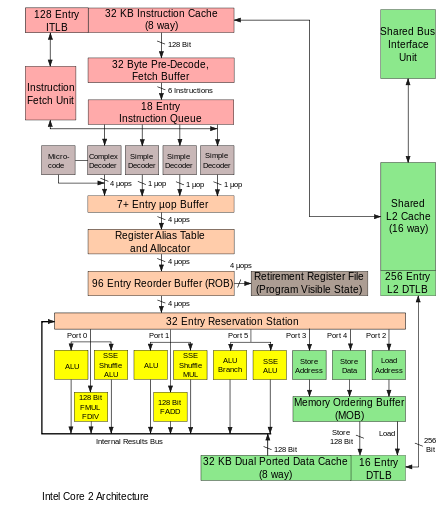Microarchitecture
The ISA includes the instructions, execution model, processor registers, address and data formats among other things.New microarchitectures and/or circuitry solutions, along with advances in semiconductor manufacturing, are what allows newer generations of processors to achieve higher performance while using the same ISA.To run programs, all single- or multi-chip CPUs: The instruction cycle is repeated continuously until the power is turned off.Early computers used ad-hoc logic design for control until Maurice Wilkes invented this tabular approach and called it microprogramming.However, the choice of instruction set architecture may greatly affect the complexity of implementing high-performance devices.The prominent strategy, used to develop the first RISC processors, was to simplify instructions to a minimum of individual semantic complexity combined with high encoding regularity and simplicity.Such uniform instructions were easily fetched, decoded and executed in a pipelined fashion and a simple strategy to reduce the number of logic levels in order to reach high operating frequencies; instruction cache-memories compensated for the higher operating frequency and inherently low code density while large register sets were used to factor out as much of the (slow) memory accesses as possible.Early designs like the SPARC and MIPS often ran over 10 times as fast as Intel and Motorola CISC solutions at the same clock speed and price.[examples needed] Large CISC machines, from the VAX 8800 to the modern Pentium 4 and Athlon, are implemented with both microcode and pipelines.Improvements in pipelining and caching are the two major microarchitectural advances that have enabled processor performance to keep pace with the circuit technology on which they are based.It was not long before improvements in chip manufacturing allowed for even more circuitry to be placed on the die, and designers started looking for ways to use it.Previously, it didn't make much sense to build a pipeline that could run faster than the access latency of off-chip memory.One barrier to achieving higher performance through instruction-level parallelism stems from pipeline stalls and flushes due to branches.The replication of functional units was only made possible when the die area of a single-issue processor no longer stretched the limits of what could be reliably manufactured.Computer architects have become stymied by the growing mismatch in CPU operating frequencies and DRAM access times.None of the techniques that exploited instruction-level parallelism (ILP) within one program could make up for the long stalls that occurred when data had to be fetched from main memory.Additionally, the large transistor counts and high operating frequencies needed for the more advanced ILP techniques required power dissipation levels that could no longer be cheaply cooled.With transaction-based applications such as network routing and web-site serving greatly increasing in the last decade, the computer industry has re-emphasized capacity and throughput issues.Once reserved for high-end mainframes and supercomputers, small-scale (2–8) multiprocessors servers have become commonplace for the small business market.Initially used in chips targeting embedded markets, where simpler and smaller CPUs would allow multiple instantiations to fit on one piece of silicon.By 2005, semiconductor technology allowed dual high-end desktop CPUs CMP chips to be manufactured in volume.This is achieved by replicating the state hardware (such as the register file and program counter) for each active thread.


List of computer system manufacturersFlynn's taxonomyInstruction setIntel Core 2electronicscomputer sciencecomputer engineeringinstruction set architectureprocessorComputer architectureassembly languageexecution modelprocessor registersarithmetic logic unitsdatapathdata flow diagramblock diagramarithmetic and logic unitregister filethree-state bufferunidirectional busesmemory address registerthree-state busschematiclogic gatescircuit diagramlogic familyIntel 80286pipelinedmicrocontrollersfloating point unitsperipheralsmemory controllersinstruction cyclemicroprogramMaurice Wilkescachingmain memoryhard diskscomputer busMoore's lawload–store architecturesdata parallelismVectorscode densityInstruction pipeliningassembly lineclassic RISC pipelineMotorolaVAX 8800CPU cachecache memorymemory hierarchyBranch predictorbranch predictionspeculative executionSuperscalarOut-of-order executionRegister renamingregisterMultiprocessingMultithreading (computer architecture)program threadonline transaction processingmainframessupercomputerspersonal computersmulti-core CPUsSun MicrosystemsUltraSPARC T1multithreadingcontext switchprogram countersimultaneous multithreadingControl unitHardware architectureHardware description languageInstruction-level parallelismList of AMD CPU microarchitecturesList of Intel CPU microarchitecturesProcessor designStream processingVery large-scale integrationVerilogHennessy, John L.Patterson, David A.Processor technologiesModelsAbstract machineStored-program computerFinite-state machinewith datapathHierarchicalDeterministic finite automatonQueue automatonCellular automatonQuantum cellular automatonTuring machineAlternating Turing machineUniversalPost–TuringQuantumNondeterministic Turing machineProbabilistic Turing machineHypercomputationZeno machineStack machineRegister machinesCounterPointerRandom-accessRandom-access stored programArchitectureVon NeumannHarvardmodifiedDataflowTransport-triggeredCellularEndiannessMemory accessLoad–storeRegister/memoryCache hierarchyVirtual memorySecondary storage